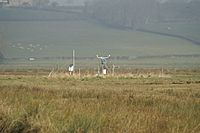Tealham and Tadham Moors facts for kids
| Site of Special Scientific Interest | |
 |
|
| Area of Search | Somerset |
|---|---|
| Coordinates | 51°12′05″N 2°49′54″W / 51.20125°N 2.83153°W |
| Interest | Biological |
| Area | 917.6 hectares (9.176 km2; 3.543 sq mi) |
| Notification | 1985 |
Tealham and Tadham Moors is a very important natural area in Somerset, England. It covers about 917.6 hectares, which is like 2,267 football fields! This special place was officially recognized in 1985 as a Site of Special Scientific Interest (SSSI). This means it's protected because of its unique plants, animals, or geology.
This area is found south of a town called Wedmore. It's also connected to another important nature site nearby, the Catcott, Edington and Chilton Moors SSSI.
Contents
What Makes Tealham and Tadham Moors Special?
Tealham and Tadham Moors is part of the larger Somerset Levels and Moors. This whole area is mostly flat, wet land with lots of fields where animals graze. It has many ditches and waterways.
Watery World: The Landscape
The ground here is often very wet, especially during winter. This is because the River Brue often overflows its banks, causing floods. This constant wetness creates a perfect home for many different kinds of plants and animals.
Amazing Plants of the Moors
Scientists have found 113 different types of plants living in the ditches and along the banks of the waterways. These include plants that grow in the water and those that grow on the land next to it. This wide variety of plants helps to support many other creatures.
Incredible Insects and Wildlife
The ditches with lots of underwater plants are especially good for tiny creatures called invertebrates. These are animals without backbones, like insects. The area is famous for its many kinds of water beetles. Some of these beetles are very rare in the UK, like the Hydrophilus piceus and Hydrochara caraboides.
You can also find rare "soldier flies" here, such as Stratiomys furcata and Odontomyia ornata. The Moors are also a great place to spot beautiful dragonflies and damselflies. Look out for the Hairy Dragonfly (Brachytron pratense) and the Variable Damselfly (Coenagrion pulchellum).

